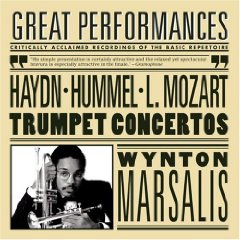Joseph Haydn – Trumpet Concerto In E-flat Major (Marsalis) [1990]
Joseph Haydn – Trumpet Concerto In E-flat Major (Marsalis) [1990]

1. Allegro
2. Andante
3. Allegro
Wynton Marsalis – trumpet
National Philharmonic Orchestra
Raymond Leppard – conductor
A favorite of the trumpet repertoire and possibly Haydn's most popular concerto, this work was composed in 1796 while the composer was working on the Creation. In the final years of his career Haydn seemed to prefer large choral works to instrumental pieces, but he was intrigued by a request for a concerto from Anton Weidinger, the trumpeter in the Vienna Court Orchestra. The valveless trumpets of the time could play only notes derived from a fundamental pitch and its related harmonic series, and so trumpet music tended to be melodically limited. Weidinger invented a keyed trumpet along the lines of a woodwind instrument; with drilled holes in the body of the instrument, the player could easily raise the pitch in half-tone steps, enabling them to play chromatic passages. The modern trumpet has been greatly refined since Weidinger's time, but the principle remains the same. Weidinger did not perform the Concerto in public until 1800. Surviving in a single manuscript copy, this extraordinary work wasn't performed again until 1929.
Splendidly orchestrated, Haydn's concerto fully exploits the trumpet's new technical abilities. The opening Allegro is festive and radiant, with the orchestra introducing the main themes before they're taken up by the soloist. There's a motif that initially rises, subsequently allowing the trumpet to show off its new stock of notes in the low register. This motif evolves into a fanfare-like subject, which the soloist enriches with effective trills and other ornamentation. The development section requires the trumpeter to play in different keys, which would have been impossible on a valveless trumpet. Opening with a lovely, expansive melody in siciliano style, the second movement reveals the full lyrical and expressive potential of the new trumpet. In addition, this movement, which exemplifies the consummate melodic artistry of Haydn's late works, showcases the instrument's ability to easily modulate from key to key. Written in a sonata rondo form, the concluding Allegro begins with an angular, fanfare-like theme, continuing with material which calls upon the soloist's dexterity in handling trills and other technical effects. Following a concise, brief development section which mainly negotiates primary thematic material, a recapitulation leads the trumpeter to a higher, brighter tessitura. A spirited combination of technical brilliance and musical élan, the third movement ends with a gleaming, celebratory coda. ---James Reel, Rovi
download: uploaded anonfiles yandex 4shared solidfiles mediafire mega filecloudio nornar
Last Updated (Monday, 06 January 2014 12:24)








